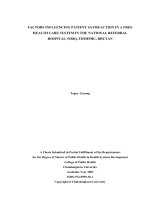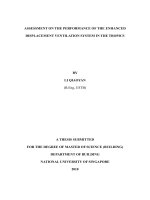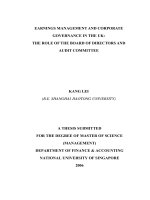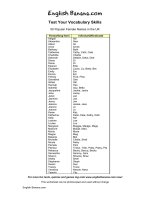70689 education system in the uk
Bạn đang xem bản rút gọn của tài liệu. Xem và tải ngay bản đầy đủ của tài liệu tại đây (263.8 KB, 2 trang )
In this text you will find general information on the education system in the UK. As there are
separate education systems in England, Scotland, Wales and Northern Ireland, the actual
ages etc. might vary a little.
School in the UK is compulsory between the ages of five and sixteen. Children younger than
five can go to a toddler group (accompanied by a parent), playgroup or nursery school.
Compulsory schooling begins at the age of five. Pupils first attend primary school, which
lasts for six years. Often primary school in the UK is divided into infant school (the first two
years) and junior school (the following 4
Age
School
years).
<5
Nursery school
5-11
Primary school
oder
5-7
Infant school
7-11
Junior school
11-18
Secondary school with
6th form
After primary school, students go to
secondary school until they are sixteen
(practical emphasis) or 18 (secondary
school with 6th form - academic
emphasis).
The school year
of three terms.
have about 12of holiday per
consists
Students
13 weeks
school
When students in the UK say what year they are in, they usually use
numbers, e. g. ‘year ten’. (In the USA, students would use ordinal
e. g. ‘tenth grade’.)
cardinal
numbers,
oder
year.
11-16
Secondary school
16-18
6th form college
Classes
At primary school, classes run Monday to Friday from about 9 a.m. to 3 p.m. There are
usually between 25 and 35 pupils in one class. They primarily learn how to read, write and
count. They also learn something about their country and about religion and they begin to
study their first foreign language.
At secondary school, classes also run Monday to Friday, but are usually from about 8.45 to
3.30. Typical mandatory subjects are English, maths, natural sciences (biology, physics,
chemistry), modern languages (French, German, Spanish), religion, citizenship, physical
education, information and communication technology, geography and history. Apart from
these, schools also offer optional courses from which their students can choose. At the age
of sixteen, students usually sit several exams and decide whether they want to leave school
or continue in a 6th form college.
Gifted and talented students can choose to enter for examinations early (one year or several
terms) and then take additional courses in these or other subjects.
Grading Scale
In the UK (as in other English speaking countries) letter grades are used in reports.
A > 80% (excellent)
B > 70% (very good)
C > 60% (improvement needed)
D > 50% (close fail)
E > 40% (fail)
F < 40% (fail)
In general, only grades A to C are a
in the UK no student has to repeat a
students can take extra lessons at
'pass'. Still,
year – weak
school.
Different Kinds of Schools
Most students in the UK are enrolled in
schools. These are financed through
parents do not have to pay for their
education. But there are also numerous private
also known as independent schools, where education is not free of charge.
state funded
taxes, so
children's
schools,
Students can choose to attend a co-educational school or a single sex school.
School Uniforms
It is common for students in the UK to wear school uniforms. They consist of:
blazer or sweater with school logo
shirt and tie or polo shirt / t-shirt
dark trousers or dark skirt
black shoes
At some schools, students are required to wear a shirt and a tie, other schools only require a
t-shirt or sweater. The colour of the uniform also depends on the school – blazer, sweater,
trousers and skirt are usually blue, grey, green or
brown.









